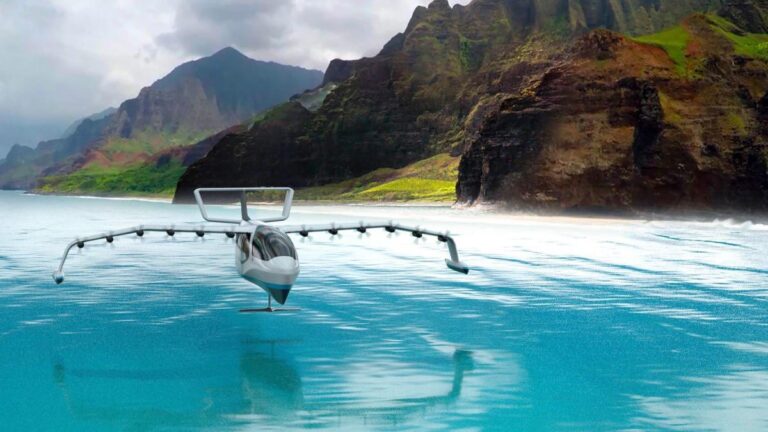Alaska Airlines’ groundbreaking partnership could soon allow travelers and vacationers to island-hop aboard a sustainable sea glider, with the mesmerizing speed of a graceful aquatic insect.
What is happening?
In January 2024, a coalition of stakeholders helped launch the Hawai’i Seaglider Initiative. The program aims to modernize Hawaii’s marine transportation network and provide reliable, clean energy solutions to protect and minimize disruption to the islands’ sacred and biodiverse ecosystems.
Alaska Airlines, which announced plans to merge with Hawaiian Airlines in late 2023, is one of the partners working with innovative developer Regent to commercialize the 12-passenger, all-electric sea glider.
Unlike traditional fixed-wing aircraft, the sea glider operates in three modes: hover (when it leaves the dock), soar (when it accelerates) and fly (once it hits open water). It’s also quieter, according to Regent, and has a range of more than 180 miles. The company estimates that next-generation batteries could increase trip lengths to as much as 500 miles per charge.
With a cruising speed of approximately 180 miles per hour, the sea glider will be able to quickly and safely transport passengers and cargo to their inter-island destinations.
Why is this encouraging?
First, it should make interisland travel more affordable. According to the Hawai’i Seaglider Initiative, these craft often have lower operating costs and require simpler infrastructure (water is a great natural runway, for example), which should lower prices for travelers.
Now Watch: Could This Concentrate Replace All the Toxic Cleaning Chemicals in Your Home?
According to the initiative’s press release, a feasibility study of the route predicts that some one-way tickets could be available for as little as $30. This is great for travelers and commuters, and would also be a boon for vital infrastructure like the transportation of goods and food, as well as medical facilities.
Second, it brings us one step closer to sustainable tourism. The aviation industry is responsible for about 2.5% of global carbon pollution, and that number is expected to rise as more people around the world start flying. However, because this sea glider is all-electric, it doesn’t emit the same harmful pollution when it’s being flown.
“Alaska Airlines is proud to support and learn from the Hawai’i Seaglider initiative, which will provide vital information about the benefits seagliders could bring to the community,” Pasha Saleh, director of corporate development at Alaska Airlines, told us via email.
“Alaska has set an ambitious goal of achieving net-zero carbon emissions by 2040. To achieve this goal, we need to look to future technologies, like the work Regent is doing with underwater gliders. … We look forward to reimagining the future of air travel with them,” Saleh said.
What is Alaska Airlines’ overall sustainability plan?
The airline is the fifth largest carrier in the United States and is among the airlines that have taken major steps in the area of sustainability.
Alaska Airlines has already launched a sustainable aviation fuel program, making it easy for individual travelers to participate in the industry’s largest lever to reduce carbon pollution. The program rewards elite-qualifying miles (hello seat upgrades) to mileage plan members who purchase sustainable aviation fuel credits.
Additionally, on a daily basis, the company’s 2023 impact report reveals that allowing customers to pre-order meals before flights reduced its food waste by 61% compared to 2019, eliminating approximately 460,000 meals from waste that could otherwise rot and produce methane in landfills.
Other green initiatives include a partnership with the Surfrider Foundation, which runs programs such as beach cleanups and raising awareness about plastic waste.
In summary : While the sea glider technology is still being developed and tested—with a launch expected in the middle of the decade—it’s an important step toward more affordable and sustainable travel options, especially in maritime areas like the Hawaiian Islands and beyond.
Join our free newsletter for weekly updates on the coolest innovations improve our lives And Save our planet.


